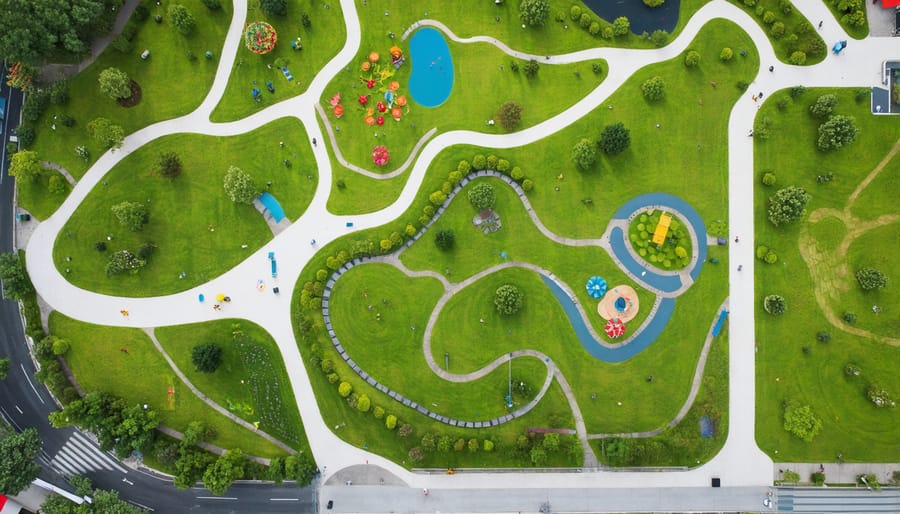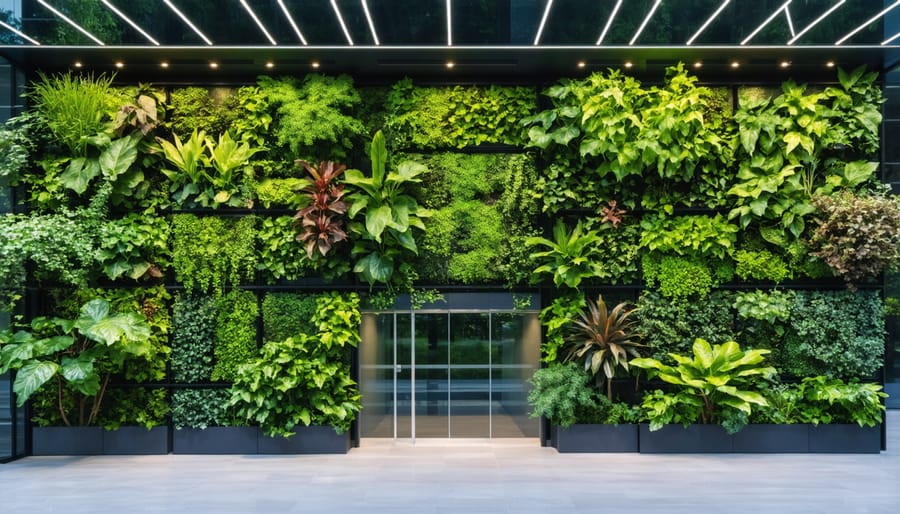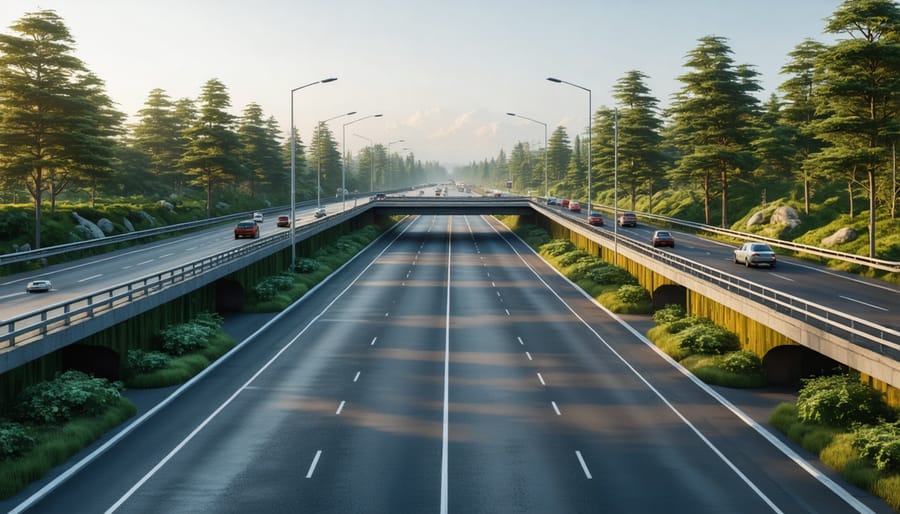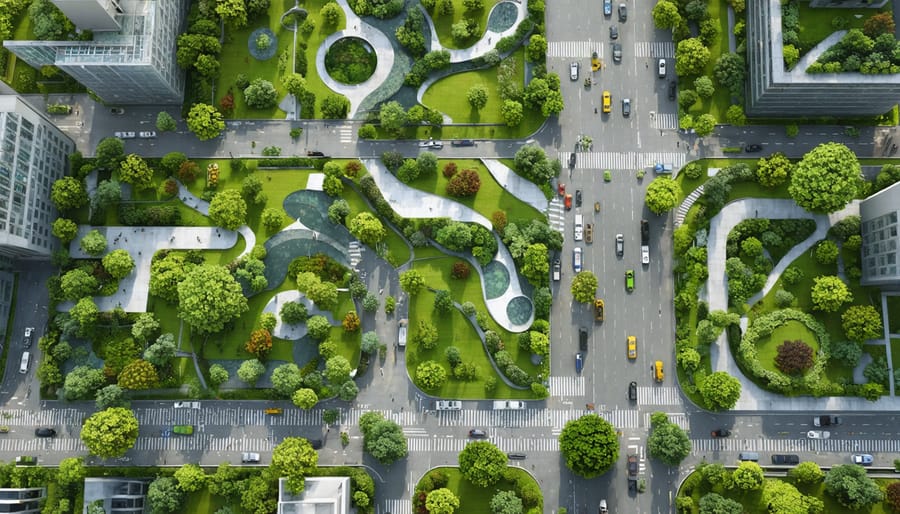In the race to combat climate change and enhance urban resilience, green infrastructure development has emerged as a cornerstone of modern city planning. From Copenhagen’s innovative bioswales managing 30% of stormwater runoff to Singapore’s vertical gardens covering over 120 hectares of building façades, cities worldwide are transforming grey urban landscapes into high-performance environmental assets. These solutions deliver measurable returns on investment: reduced flooding risks, decreased urban heat island effects, and enhanced air quality, while generating substantial cost savings in traditional infrastructure maintenance. For construction professionals and urban planners, implementing green infrastructure represents not just an environmental imperative but a strategic advantage in securing sustainable urban development contracts. This technical overview examines cutting-edge examples of urban green infrastructure, complete with performance metrics, implementation strategies, and cost-benefit analyses derived from successful projects across major metropolitan areas.
Urban Parks and Bioswales
Living Parks Systems
Living park systems represent a sophisticated approach to urban green infrastructure, integrating stormwater management with public recreation spaces. Notable examples include Portland’s Green Loop, a six-mile corridor connecting parks and green spaces while incorporating bioswales and rain gardens for natural water filtration.
Singapore’s Park Connector Network (PCN) exemplifies successful implementation at scale, linking major parks and natural areas across the city-state through green corridors that serve multiple functions. These connectors feature permeable pavements, native vegetation, and innovative drainage systems that reduce urban runoff while providing cycling and pedestrian infrastructure.
Chicago’s 606 Trail transformed an abandoned railway line into an elevated park system that manages stormwater through specialized soil systems and vegetation. The project captures approximately 80% of rainfall events through strategic placement of native plants and engineered soils.
Copenhagen’s Cloudburst Management Plan integrates park networks with flood control, creating multi-functional spaces that transform into water storage during heavy rainfall events. These spaces include sunken sports courts, tiered gardens, and landscaped retention areas that can temporarily hold water while maintaining recreational functionality during dry periods.
These systems demonstrate how cities can maximize limited urban space by combining ecological services with community amenities, creating resilient infrastructure that serves multiple purposes.

Bioswale Networks
Several major cities have successfully implemented bioswale networks as integral components of their green infrastructure strategies. Portland, Oregon stands as a pioneer with its Green Streets program, which has installed over 2,000 bioswales throughout the city. These installations manage approximately 80% of stormwater runoff while reducing peak flows by up to 85% during heavy rainfall events.
In Seattle, the SEA Street project (Street Edge Alternatives) demonstrates the effectiveness of interconnected bioswales. The system reduces stormwater runoff by 99% through a series of cascading bioswales integrated with native vegetation. This network has proven particularly successful during the Pacific Northwest’s characteristic wet seasons.
New York City’s Staten Island Bluebelt program represents another notable implementation, incorporating bioswales into a larger watershed management system. The network spans 16 drainage areas and manages stormwater from approximately 14,000 acres. The project has saved the city an estimated $80 million in infrastructure costs compared to traditional storm sewer systems.
Copenhagen’s Climate Adaptation Plan features strategic bioswale placement throughout the city center, designed to handle increasing precipitation levels. The system processes up to 30% of surface water runoff while creating green corridors that enhance urban biodiversity and improve air quality.
This initiative aligns with global efforts to reduce building emissions, highlighting the dual benefits of innovative water management and climate action.
Green Roofs and Vertical Gardens
Commercial Green Roofs
Commercial green roofs represent one of the most impactful green roof implementations in urban environments, offering substantial environmental and economic benefits for large-scale buildings. Notable examples include the 2.5-acre living roof atop Facebook’s MPK 20 building in Menlo Park, California, which incorporates native species and walking trails while managing stormwater runoff and reducing heating costs by up to 25%.
The Ford Rouge Center in Dearborn, Michigan, showcases a 10.4-acre extensive green roof system designed by William McDonough. This installation effectively manages annual stormwater runoff of 450,000 cubic feet while extending the roof’s lifespan to 40+ years. The sedum-based vegetation requires minimal maintenance while providing significant thermal insulation.
Chicago’s City Hall green roof project demonstrates urban heat island mitigation, achieving temperature reductions of up to 78°F compared to neighboring conventional roofs during peak summer conditions. The 20,000-square-foot installation has also reduced annual energy costs by $5,000.
These commercial implementations typically utilize modular systems or built-up layering techniques, incorporating waterproofing membranes, drainage layers, growing medium, and carefully selected vegetation. Return on investment analyses indicate typical payback periods of 3-7 years through reduced energy consumption, extended roof longevity, and decreased stormwater management costs.

Living Walls
Living walls, also known as vertical gardens or green facades, represent a significant advancement in urban green infrastructure. These systems typically consist of pre-vegetated panels, vertical modules, or planted blankets attached to building facades or freestanding frames. Notable implementations include the One Central Park in Sydney, featuring over 1,100 square meters of vertical greenery, and the Musée du Quai Branly in Paris, which showcases 800 square meters of living wall designed by botanist Patrick Blanc.
The environmental benefits of living walls are substantial. They can reduce building energy consumption by 23-25% through natural insulation and shade provision. These systems capture particulate matter, with studies showing that a 10-square-meter living wall can trap up to 4kg of airborne particles annually. Additionally, they contribute to urban biodiversity by providing habitats for insects and birds.
Modern living wall systems incorporate sophisticated irrigation and monitoring technology. Hydroponic systems deliver precise nutrient solutions, while sensors maintain optimal soil moisture levels. Construction professionals can choose between modular systems, which offer easier maintenance and replacement of individual panels, or continuous systems that provide seamless vegetative coverage.
Maintenance considerations include quarterly inspections of irrigation systems, annual soil testing, and periodic pruning. While initial installation costs range from $500 to $1,200 per square meter, the long-term benefits in energy savings and improved air quality make living walls an increasingly attractive option for sustainable urban development.
Sustainable construction practices like these are integral to pioneering a greener future for the built environment.
Sustainable Urban Drainage Systems
Permeable Pavements
Permeable pavements represent a significant advancement in sustainable urban infrastructure, offering both practical functionality and environmental benefits. These innovative surfaces allow stormwater to infiltrate through the pavement structure rather than generating surface runoff. Major implementations include the Portland Green Streets program, which has successfully installed over 50,000 square feet of permeable pavement in high-traffic areas, reducing stormwater runoff by 60%.
Notable materials used in permeable pavement systems include pervious concrete, porous asphalt, and interlocking pavers. The Chicago Green Alley initiative demonstrates the effectiveness of these materials, with over 300 alleys retrofitted using permeable surfaces, resulting in a 30% reduction in local flooding incidents.
Beyond water management, these systems provide additional advantages such as reduced heat island effect, improved groundwater recharge, and decreased need for traditional drainage infrastructure. The Seattle RainWise program reported a 90% reduction in stormwater runoff where permeable pavements were installed, while also noting a 15% reduction in surface temperatures during summer months.
Installation costs typically range from $10-15 per square foot, but long-term maintenance savings and environmental benefits often justify the initial investment. Projects must consider factors such as soil conditions, traffic loads, and maintenance requirements for optimal performance.
Rain Gardens
Rain gardens have emerged as highly effective urban stormwater management solutions, with several notable implementations demonstrating their success in major cities. Portland’s Green Streets program stands as a prime example, featuring over 2,000 rain gardens that manage approximately 48 million gallons of stormwater annually. These installations have reduced local flooding by 85% while providing aesthetic benefits to the streetscape.
In Seattle, the SEA Street Project (Street Edge Alternatives) showcases how rain gardens can be integrated into existing residential areas. The project reduced stormwater runoff by 99% during typical rain events, while creating valuable urban habitat corridors. Construction costs were 25% lower than traditional stormwater infrastructure, demonstrating significant cost advantages.
Kansas City’s 10,000 Rain Gardens initiative presents another successful case study, where strategically placed bioretention systems handle runoff from approximately 180 acres of impervious surface. The gardens incorporate native plants that thrive in local conditions, requiring minimal maintenance while providing maximum stormwater retention capacity.
These implementations share common success factors: proper soil composition (typically 60% sand, 20% topsoil, and 20% compost), strategic placement in relation to existing drainage patterns, and careful plant selection based on local climate conditions. Monitoring data indicates that well-designed rain gardens can filter up to 90% of common pollutants from runoff while reducing peak flow rates by 60%.
Urban Wildlife Corridors
Linear Parks
Linear parks represent innovative urban corridors that transform underutilized spaces into vibrant ecological connectors. These elongated green spaces, often developed along abandoned railway lines or waterways, serve multiple functions in urban environments while supporting biodiversity and sustainable transportation.
Notable examples include New York’s High Line, which has become a blueprint for similar projects worldwide. This elevated park spans 1.45 miles through Manhattan, featuring native plantings that provide habitat for local wildlife species and demonstrate how industrial infrastructure can be repurposed for ecological benefit.
The design of linear parks typically incorporates layered vegetation strategies, including ground cover, shrubs, and canopy trees, creating diverse ecosystems that support urban wildlife corridors. These green corridors also serve as natural stormwater management systems, with permeable surfaces and bioswales that filter runoff and reduce pressure on municipal drainage infrastructure.
From a construction perspective, linear parks present unique challenges in soil depth management, structural load considerations, and irrigation system design. However, their implementation has proven to deliver significant returns in terms of increased property values, improved air quality, and enhanced urban mobility through integrated cycling and pedestrian pathways.
Wildlife Passages
Wildlife passages represent critical components of urban green infrastructure, designed to maintain habitat connectivity and reduce human-wildlife conflicts. These engineered solutions include wildlife overpasses, underpasses, culverts, and eco-ducts that enable safe animal movement across urban barriers.
Notable examples include Singapore’s Eco-Link@BKE, an hourglass-shaped ecological bridge spanning the Bukit Timah Expressway, which successfully connects two nature reserves. In Canada, Banff National Park features a network of 38 wildlife underpasses and six overpasses, demonstrating how such infrastructure can be integrated into urban peripheries.
European cities have pioneered innovative designs, such as the Netherlands’ Natuurbrug Zanderij Crailoo, the world’s longest wildlife bridge at 800 meters. These passages typically incorporate native vegetation, sound barriers, and specific substrate materials to encourage animal use.
Construction professionals should consider key design elements including approach angles, vegetation coverage, and noise reduction features. Monitoring data shows these passages significantly reduce wildlife-vehicle collisions while maintaining genetic diversity among urban wildlife populations. Cost-benefit analyses indicate long-term savings through reduced accident rates and ecological preservation.

Future Trends and Implementation Strategies
As we look ahead, several transformative trends are reshaping green infrastructure implementation in urban environments. Smart city integration is emerging as a key driver, with IoT sensors and data analytics being deployed to optimize green roof performance, monitor stormwater management systems, and regulate urban forest health in real-time.
Modular and prefabricated green infrastructure solutions are gaining traction, offering faster installation and reduced on-site disruption. These standardized components, such as pre-grown living wall panels and engineered soil systems, help streamline implementation while maintaining quality control.
Climate resilience is becoming central to green infrastructure planning, with designs increasingly incorporating adaptive features to handle extreme weather events. This includes the development of hybrid systems that combine traditional gray infrastructure with green elements for enhanced performance and reliability.
For successful implementation, organizations should follow a systematic approach:
1. Conduct comprehensive site analysis and feasibility studies
2. Engage stakeholders early in the planning process
3. Develop clear maintenance protocols and responsibility frameworks
4. Establish performance metrics and monitoring systems
5. Create phased implementation plans that allow for scaling
Financial considerations remain crucial, with innovative funding mechanisms emerging. Green bonds, public-private partnerships, and stormwater credits are becoming more common, making green infrastructure projects more financially viable for cities and developers.
Technology integration is advancing rapidly, with digital twin modeling and AI-powered maintenance systems helping optimize performance and reduce operational costs. These tools enable predictive maintenance and better resource allocation.
Looking forward, we can expect increased emphasis on biodiversity and ecosystem services, with projects designed to support local species and enhance natural habitats. The integration of urban agriculture within green infrastructure systems is also gaining momentum, supporting food security initiatives while maximizing space utilization.
To ensure long-term success, organizations must focus on capacity building, training maintenance staff, and developing standard operating procedures. Regular monitoring and adjustment of systems based on performance data will be essential for optimizing outcomes and demonstrating value to stakeholders.
Green infrastructure has proven to be a transformative force in urban development, delivering measurable benefits in stormwater management, air quality improvement, and urban heat reduction. Cities implementing these solutions have reported significant cost savings compared to traditional gray infrastructure, while simultaneously enhancing community resilience and biodiversity. Looking ahead, the integration of smart technology with green infrastructure presents exciting possibilities for optimization and monitoring. As climate change challenges intensify, we can expect to see more cities adopting comprehensive green infrastructure strategies, supported by evolving building codes and sustainability regulations. The future of urban development lies in the successful fusion of natural systems with built environments, creating cities that are not only more sustainable but also more livable for generations to come.

